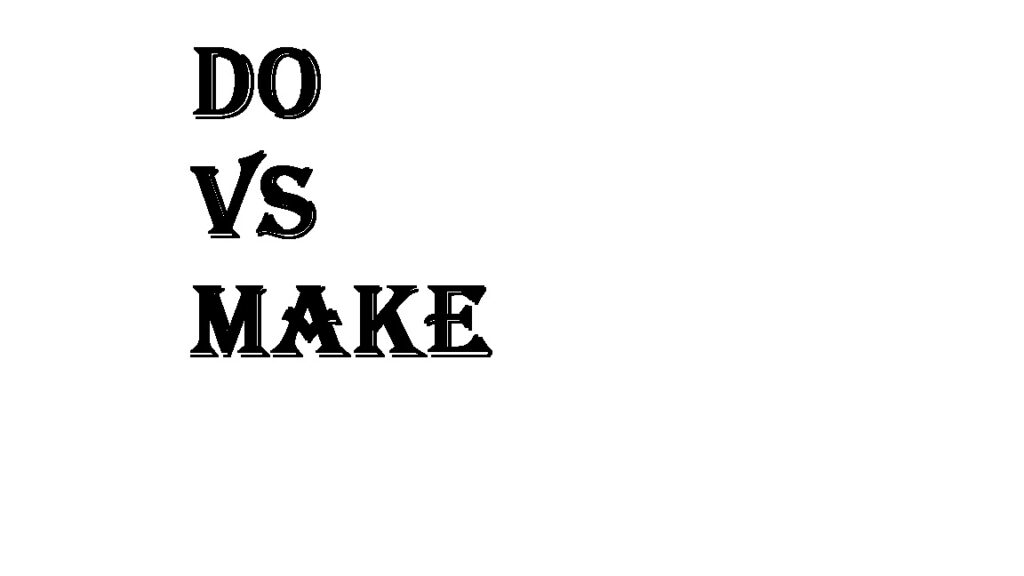Let’s explore the difference between “do” and “make” and provide some explanations and examples for each.
The Difference between “Do” and “make”
“Do” is a general verb that can be used to describe various actions, tasks, or activities.
It is often used when referring to tasks that don’t involve creating or producing something tangible.
“Do” is commonly used when talking about daily routines, chores, or actions that require effort or completion.
Examples:
“I need to do my homework.”
“She does yoga every morning.”
“They did the dishes after dinner.”
“He’s doing his best to succeed.”
“Make”:
“Make” typically implies creating, constructing, or producing something tangible or specific.
It is used when referring to the act of bringing something into existence or producing a result.
“Make” is frequently used when discussing crafts, cooking, manufacturing, or any activity that involves creating something new.
Examples:
“She makes beautiful paintings.”
“He made a delicious cake.”
“They are making a table out of wood.”
“I want to make a positive impact on the world.”
In summary, “do” is a more general verb used for actions or tasks, while “make” is specific to the act of creating or producing something tangible. Here’s a helpful way to remember the difference: “do” is about actions and tasks, while “make” is about creating or producing something new.
Please note that there are exceptions and overlapping uses of these verbs, and their usage can vary depending on the context.
more examples of when to use “do” in a sentence:
Daily routines and activities:
“I need to do my laundry.”
“She does her hair before going out.”
“He does the grocery shopping every Saturday.”
Work and professional tasks:
“They have a lot of work to do today.”
“I need to do some research for my presentation.”
“She’s doing a great job as a project manager.”
Household chores:
“Don’t forget to do the dishes after dinner.”
“He always does the vacuuming on weekends.”
“I’ll do the cleaning while you take care of the laundry.”
Physical activities and exercises:
“They do yoga to stay flexible and relaxed.”
“He does push-ups and sit-ups every morning.”
“We should do some stretching before the workout.”
Academic tasks:
“I have to do my math homework tonight.”
“She’s doing a research paper on climate change.”
“They did well on their science project.”
Expressions and idioms:
“I can’t believe he did me a favor.”
“She did her best to solve the problem.”
“He did a great job on the presentation.”
Remember, “do” is a versatile verb that can be used in various contexts to describe tasks, actions, routines, and more.
some examples of when to use “make” instead of “do” in a sentence:
Creative activities:
“She makes beautiful jewelry.”
“He made a sculpture out of clay.”
“They are making a quilt for their friend’s baby.”
Cooking and food preparation:
“Let’s make a delicious lasagna for dinner.”
“She made a batch of chocolate chip cookies.”
“He’s making a homemade pizza from scratch.”
Crafting and DIY projects:
“They made a birdhouse out of recycled materials.”
“She’s making a handmade greeting card.”
“He made a wooden shelf for his books.”
Building or constructing:
“They are making renovations to their house.”
“He made a treehouse for his kids in the backyard.”
“We’re making a sandcastle on the beach.”
Creating or forming something:
“She made a plan to achieve her goals.”
“He made a decision after careful consideration.”
“They made a commitment to support each other.”
Manufacturing or producing:
“The factory makes cars on a large scale.”
“They make high-quality leather bags.”
“He made a fortune by making and selling handmade soaps.”
Remember, “make” is used when there’s a tangible outcome or creation involved, such as cooking, crafting, building, or producing something. It emphasizes the act of bringing something into existence.
Find us on Facebook
More about English Common core

